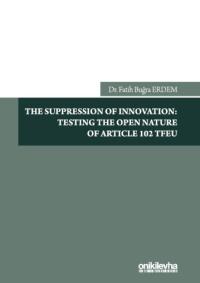The Suppression Of Innovation: Testing The Open Nature Of Article 102 TFEU
Dr. Fatih Buğra ERDEM
Table of Contents
Chapter 1
Introduction
1.1. The Rationale of the Research
1.2. The Scope of the Research
1.3. Research Questions
1.4. Literature Review
1.5. Contribution to the Knowledge
1.6. Methodology
1.7. Structure of the Book
Chapter 2
Theoretical Framework Of Innovation Suppression
2.1. Introduction
2.2. Definition of innovation
2.3. The concept of the new economy
2.4. Characteristics of the new economy
2.5. The cost of ınnovation: the trade-off between price, quality and innovation
2.6. Conclusion
Chapter 3
Suppression of Innovation in the Context of EU Competition Law
3.1. Introduction
3.2. Analysis of innovation considerations in the framework of EU competition law
3.3. Theoretical analysis of innovation suppression in terms of competition and intellectual property laws
3.4. Conclusion
Chapter 4
Frequently Encountered Patents Related Instances of the Suppression of Innovation in the Context of EU Competition Law
4.1. Introduction
4.2. The non-use of patent rights
4.3. Pay-for-delay agreements
4.4. Standardisation
4.5. Spare part designs protection: Suppression of innovation by locking-in consumers and knocking-out competitors
4.6. Evergreening patents as blockers of innovation
4.7. Overall Conclusion of the Chapter
Chapter 5
Suppression of Innovation via Predatory Innovation and Exclusionary Product Design: The Case of Planned Obsolescence
5.1. Introduction
5.2. The concept of planned obsolescence
5.3. Does planned obsolescence underrated or unnoticed issue?
5.4. What steps have been taken concerning planned obsolescence in the EU?
5.5. How much freedom do manufacturers have in the product design?
5.6. Planned obsolescence as an exclusionary product design practice
5.7. A legal treatment of planned obsolescence in the context of the EU competition law
5.8. Conclusion
Chapter 6
Final Conclusion
6.1. Summary of the Research
6.2. Contribution and Recommendations of the Research
6.3. Areas of Future Research
Bibliography


